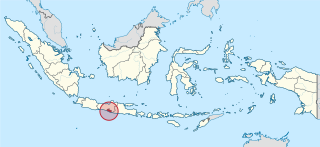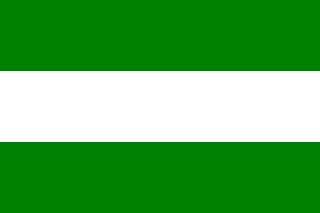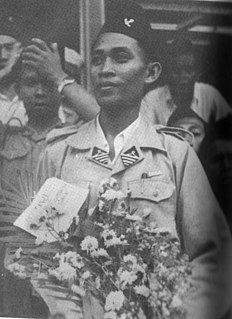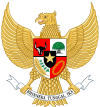
The history of Indonesia has been shaped by its geographic position, its natural resources, a series of human migrations and contacts, wars and conquests, as well as by trade, economics and politics. Indonesia is an archipelagic country of 17,000 to 18,000 islands stretching along the equator in South East Asia. The country's strategic sea-lane position fostered inter-island and international trade; trade has since fundamentally shaped Indonesian history. The area of Indonesia is populated by peoples of various migrations, creating a diversity of cultures, ethnicities, and languages. The archipelago's landforms and climate significantly influenced agriculture and trade, and the formation of states. The boundaries of the state of Indonesia match the 20th-century borders of the Dutch East Indies.

The Indonesian National Revolution, or the Indonesian War of Independence, was an armed conflict and diplomatic struggle between the Republic of Indonesia and the Dutch Empire and an internal social revolution during postwar and postcolonial Indonesia. It took place between Indonesia's declaration of independence in 1945 and the Netherlands' transfer of sovereignty over the Dutch East Indies to the Republic of the United States of Indonesia at the end of 1949.

The Special Region of Yogyakarta is a provincial-level autonomous region of Indonesia in southern Java. It has also been known as the Special Territory of Yogyakarta.

Priyayi was the Dutch-era class of the nobles of the robe, as opposed to royal nobility or ningrat (Javanese), in Java, Indonesia, the world's most populous island.

The Renville Agreement was a United Nations Security Council-brokered political accord between the Netherlands, which was seeking to re-establish its colony in South East Asia, and Indonesian Republicans seeking to secure Indonesian independence during the Indonesian National Revolution. Ratified on 17 January 1948, the agreement was an unsuccessful attempt to resolve the disputes that arose following the 1946 Linggadjati Agreement. It recognised a cease-fire along the Status Quo Line or so-called "Van Mook Line", an artificial line which connected the most advanced Dutch positions.

Darul Islam, also known as Darul Islam/Islamic Armed Forces of Indonesia, was an Islamist group that fought for the establishment of an Islamic state in Indonesia. It was established in 1942 by a group of Muslim militias, coordinated by a charismatic radical Muslim politician, Sekarmadji Maridjan Kartosoewirjo. The group recognised only Shari'a as the valid source of law. The movement has produced splinters and offshoots that range from Jemaah Islamiyah to non-violent religious groups.

The Empire of Japan occupied the Dutch East Indies during World War II from March 1942 until after the end of the war in September 1945. It was one of the most crucial and important periods in modern Indonesian history.

This is the Timeline of Indonesian National Revolution (1945–1950)

The State of East Indonesia was a post–World War II state formed in the eastern half of Dutch East Indies by the Netherlands. Established in December 1946, it became part of the United States of Indonesia in 1949 at the end of the Indonesian National Revolution, and was dissolved in 1950 with the end of the USI. It comprised all the islands to the east of Borneo and of Java.

The Central Indonesian National Committee, or KNIP, was a body appointed to assist the president of the newly independent Indonesia. Originally purely advisory, it later gained assumed legislative functions. The Working Committee of the KNIP became part of the People's Representative Council when Indonesia became a unitary state in 1950.

Bersiap is the name given by the Dutch to a violent and chaotic phase of the Indonesian National Revolution following the end of World War II. The Indonesian word bersiap means 'get ready' or 'be prepared'. The Bersiap period lasted from August 1945 to November 1947. In Indonesia, other terms aside from bersiap are commonly used, such as gedoran in Depok, ngeli in Banten and surrounding West Java, and gegeran and dombreng in Central Java.

The State of East Sumatra was established by the Netherlands after the reoccupation of North Sumatra in July, 1947, during the first of the Dutch "police actions" against the fledgling Republic of Indonesia. In 1949, as part of a peace deal that concluded the Indonesian National Revolution, it joined the United States of Indonesia, of which the Republic was also a component state. In August, 1950, it was absorbed into the Republic as part of the province of North Sumatra. The area covered by the former state included the present-day regencies of Langkat, Deli Serdang, Serdang Bedagai, Karo, Simalungan, Batubara and Asahan, together with the cities geographically within those regencies.

The State of Pasundan was a federal state (negara bagian) formed in the western part of the Indonesian island of Java by the Netherlands in 1948 following the Linggadjati Agreement. It was similar to the geographical area now encompassed by the current provinces of West Java, Banten and Jakarta.

The United States of Indonesia, was a short-lived federal state to which the Netherlands formally transferred sovereignty of the Dutch East Indies on 27 December 1949 following the Dutch-Indonesian Round Table Conference. This transfer ended the four-year conflict between Indonesian nationalists and the Netherlands for control of Indonesia. It lasted less than a year, before being replaced by the unitary Republic of Indonesia.

The State of Madura was a federal state (negara bagian) formed on the Indonesian island of Madura by the Netherlands in 1948 as part of an attempt to reestablish the colony of the Dutch East Indies during the Indonesian National Revolution. It included Madura and neighbouring islands that now form part of the current province of East Java.

The military history of Indonesia includes the military history of the modern nation of Republic of Indonesia, as well as the military history of the states which preceded and formed it. It encompassed a kaleidoscope of conflicts spanning over a millennia. The ancient and medieval part of it began as tribal warfare began among indigenous populations, and escalated as kingdoms emerged. The modern part is defined by foreign colonial occupations, battles for independence through guerrilla warfare during Indonesian National Revolution, regional conquests and disputes with neighbouring countries, as well as battles between the Republic and separatist factions. Since the formation of the Republic, the military has played significant role in state affairs. However, in Post-Suharto era, the Indonesian military has retreated from politics, yet it still possesses some influences.

The Darul Islam rebellion was a war waged between 1949 and 1962 by the Islamic State of Indonesia, commonly known as Darul Islam, to establish an Islamic state in Indonesia. The rebellion began when Sekarmadji Maridjan Kartosuwirjo, a nationalist who had resisted the Dutch during the Indonesian National Revolution, refused to recognize the new Republic of Indonesia. Instead, he proclaimed the establishment of the Islamic State of Indonesia on 7 August 1949.

Dr. Raden Valentinus Sudjito Dwijoatmojo was a politician from the Catholic Party. He chaired the legislature of Central Java—serving as the leader of the region—from 1949 until 1950. He was also the member of the Senate, the Provisional People's Representative Council, and the Constitutional Assembly.

Djumhana Wiriaatmadja was a Sundanese aristocrat, regent, politician, and diplomat.

The Kalimantan Physical Revolution was an armed conflict between Indonesian nationalists in and pro-Dutch forces in Dutch Borneo following the end of the Japanese occupation of the Dutch East Indies and the 1945 Proclamation of Indonesian Independence by Sukarno and which lasted until the Dutch withdrew from most of Indonesia in 1949. It can be considered a regional conflict in the larger Indonesian National Revolution. After the surrender of the Japanese at the end of World War II, allied forces took control of the Dutch East Indies, including Dutch Borneo. The return of Dutch authorities however, was rejected by majority of native population, including in Borneo, resulting in various regional armed conflicts between Royal Netherlands East Indies Army and Indonesian nationalist forces. Allied military forces in Borneo were in a strong position after an early conflict in August 1945, and were able to pacify local nationalist uprisings and impose a blockade to prevent military aid and exchange in personnel from nationalist strongholds in Java and Sumatra. Later, nationalists with connections to Borneo were able to breach the military blockade to provide information of revolutionary events in Java and Sumatra, declaring Kalimantan as inseparable part of the new Indonesian republic.


















